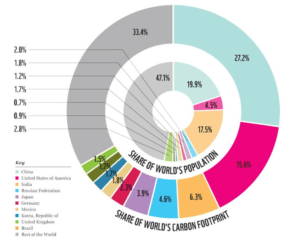B. What is a carbon footprint?
E. Components of a Carbon Footprint
F. How Carbon Footprint is Measured
G. Carbon Footprint in Daily Life
K. Factors Influencing Carbon Footprint
M. Government Policies on Carbon Footprint
N. Corporate Responsibility in Carbon Management
O. Technological Innovations in Reducing Carbon Footprint
P. Future of Carbon Footprint Management
Q. Conclusion
Accurately determining the carbon footprint allows people, groups, and governments to pinpoint high-emission locations, establish targets for reduction, put plans in place to reduce environmental effects, and monitor advancement toward sustainability objectives over time.
FAQs
- What is a carbon footprint and why is it important?
A carbon footprint measures the total greenhouse gases emitted by an individual, organization, event, or product, expressed in carbon dioxide equivalents. It’s important because it quantifies the impact of human activities on climate change, highlighting areas for improvement in reducing emissions and mitigating global warming. - How is a carbon footprint calculated?
A carbon footprint is calculated by assessing the emissions from various activities such as energy use, transportation, and waste production. This involves converting all greenhouse gases into a common unit, usually carbon dioxide equivalents, using specific emission factors for each activity. - What are the main contributors to a carbon footprint?
The main contributors to a carbon footprint include energy consumption (electricity and heating), transportation (cars, planes), industrial processes, agriculture, and waste management. These activities release significant amounts of greenhouse gases, primarily carbon dioxide, methane, and nitrous oxide. - How can individuals reduce their carbon footprint?
Individuals can reduce their carbon footprint by adopting energy-efficient appliances, using public transport or cycling, reducing meat consumption, recycling, and conserving water. Additionally, supporting renewable energy sources and minimizing air travel can significantly lower personal emissions. - What is the difference between a carbon footprint and a carbon offset?
A carbon footprint measures the total greenhouse gases emitted by an activity, while a carbon offset involves compensating for those emissions by funding projects that reduce or remove an equivalent amount of greenhouse gases, such as reforestation or renewable energy initiatives. - How does a carbon footprint impact climate change?
A carbon footprint contributes to climate change by adding greenhouse gases to the atmosphere, which trap heat and cause global temperatures to rise. This leads to extreme weather events, rising sea levels, and disruptions to ecosystems and human communities. - What are some examples of high carbon footprint activities?
High carbon footprint activities include driving gasoline-powered cars, flying frequently, consuming a meat-heavy diet, using non-renewable energy for heating and electricity, and producing large amounts of waste without recycling. - Can businesses measure their carbon footprint?
Yes, businesses can measure their carbon footprint by analyzing their energy use, transportation, production processes, and waste management. Tools and frameworks, such as the Greenhouse Gas Protocol, help businesses assess and report their emissions accurately. - What tools are available to calculate a carbon footprint?
Tools available to calculate a carbon footprint include online calculators, software like the Carbon Trust Footprint Calculator, and frameworks such as the Greenhouse Gas Protocol. These tools use data on energy use, travel, and waste to estimate emissions. - How does transportation affect your carbon footprint?
Transportation significantly affects your carbon footprint, especially if you rely on fossil fuel-powered vehicles. Cars, planes, and ships emit large amounts of carbon dioxide. Using public transport, carpooling, cycling, or walking can reduce your transportation emissions. - What role does energy consumption play in a carbon footprint?
Energy consumption is a major component of a carbon footprint. Using electricity, heating, and cooling, especially from non-renewable sources, emits significant greenhouse gases. Reducing energy use and switching to renewable energy sources can lower these emissions. - How can diet and food choices influence your carbon footprint?
Diet and food choices greatly influence your carbon footprint. Meat and dairy production generate high greenhouse gas emissions due to livestock farming practices. Reducing meat intake, eating locally-sourced produce, and minimizing food waste can lower your food-related carbon footprint. - What are the benefits of reducing your carbon footprint?
Reducing your carbon footprint helps mitigate climate change, improve air quality, and conserve natural resources. It can also lead to cost savings on energy bills, healthier lifestyles, and a positive impact on biodiversity and ecosystems. - What is the global average carbon footprint per person?
The global average carbon footprint per person is approximately 4 to 5 metric tons of CO2 per year. This varies widely between countries, with higher averages in developed nations and lower averages in developing countries. - How does recycling impact your carbon footprint?
Recycling reduces your carbon footprint by decreasing the need for new raw materials,






[…] A net-zero carbon footprint is the intended result of balancing out the emissions generated by the organization. […]
[…] are absolutely essential to lessening the influence of the building sector. A large amount of world carbon emissions come from the building sector; sustainable building methods help to lower these emissions and fight […]
[…] absolutely essential to lessening the influence of the building sector. A large amount of global carbon emissions come from the building sector; sustainable building methods help to lower these emissions and fight […]
[…] Benefits: Renewable energy has a much lower carbon footprint and environmental impact compared to fossil fuels, helping to mitigate climate change and reduce […]
[…] Compared to incineration, which releases significant amounts of carbon dioxide, pyrolysis has a lower carbon footprint. […]
[…] interior design seeks to reduce the bad impact of indoor environments on the surroundings. Building carbon footprints can be greatly lowered by designers employing environmentally friendly materials and […]
Ny weekly I just like the helpful information you provide in your articles
Family Dollar I’m often to blogging and i really appreciate your content. The article has actually peaks my interest. I’m going to bookmark your web site and maintain checking for brand spanking new information.
[…] performance within the transport industry. These efforts aim to lower the sector’s carbon footprint and promote […]